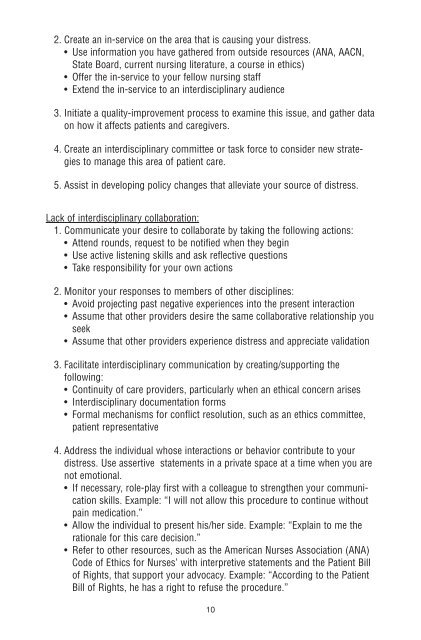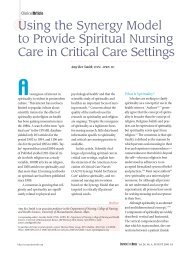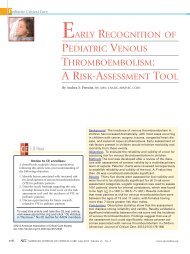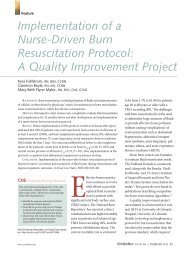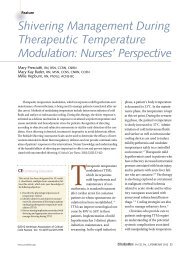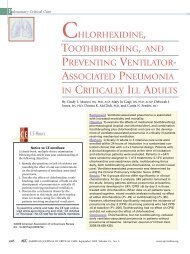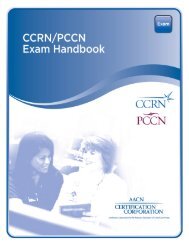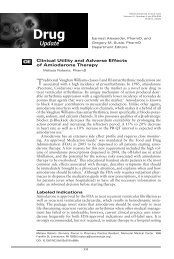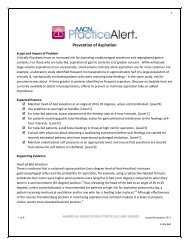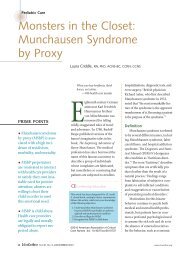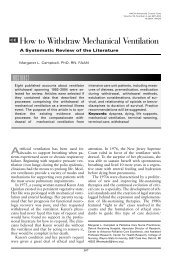The 4A's to Rise Above Moral Distress - American Association of ...
The 4A's to Rise Above Moral Distress - American Association of ...
The 4A's to Rise Above Moral Distress - American Association of ...
You also want an ePaper? Increase the reach of your titles
YUMPU automatically turns print PDFs into web optimized ePapers that Google loves.
2. Create an in-service on the area that is causing your distress.<br />
• Use information you have gathered from outside resources (ANA, AACN,<br />
State Board, current nursing literature, a course in ethics)<br />
• Offer the in-service <strong>to</strong> your fellow nursing staff<br />
• Extend the in-service <strong>to</strong> an interdisciplinary audience<br />
3. Initiate a quality-improvement process <strong>to</strong> examine this issue, and gather data<br />
on how it affects patients and caregivers.<br />
4. Create an interdisciplinary committee or task force <strong>to</strong> consider new strategies<br />
<strong>to</strong> manage this area <strong>of</strong> patient care.<br />
5. Assist in developing policy changes that alleviate your source <strong>of</strong> distress.<br />
Lack <strong>of</strong> interdisciplinary collaboration:<br />
1. Communicate your desire <strong>to</strong> collaborate by taking the following actions:<br />
• Attend rounds, request <strong>to</strong> be notified when they begin<br />
• Use active listening skills and ask reflective questions<br />
•Take responsibility for your own actions<br />
2. Moni<strong>to</strong>r your responses <strong>to</strong> members <strong>of</strong> other disciplines:<br />
•Avoid projecting past negative experiences in<strong>to</strong> the present interaction<br />
• Assume that other providers desire the same collaborative relationship you<br />
seek<br />
• Assume that other providers experience distress and appreciate validation<br />
3. Facilitate interdisciplinary communication by creating/supporting the<br />
following:<br />
• Continuity <strong>of</strong> care providers, particularly when an ethical concern arises<br />
• Interdisciplinary documentation forms<br />
• Formal mechanisms for conflict resolution, such as an ethics committee,<br />
patient representative<br />
4. Address the individual whose interactions or behavior contribute <strong>to</strong> your<br />
distress. Use assertive statements in a private space at a time when you are<br />
not emotional.<br />
• If necessary, role-play first with a colleague <strong>to</strong> strengthen your communication<br />
skills. Example: “I will not allow this procedure <strong>to</strong> continue without<br />
pain medication.”<br />
• Allow the individual <strong>to</strong> present his/her side. Example: “Explain <strong>to</strong> me the<br />
rationale for this care decision.”<br />
• Refer <strong>to</strong> other resources, such as the <strong>American</strong> Nurses <strong>Association</strong> (ANA)<br />
Code <strong>of</strong> Ethics for Nurses’ with interpretive statements and the Patient Bill<br />
<strong>of</strong> Rights, that support your advocacy. Example: “According <strong>to</strong> the Patient<br />
Bill <strong>of</strong> Rights, he has a right <strong>to</strong> refuse the procedure.”<br />
10


